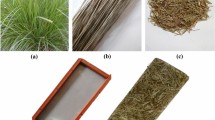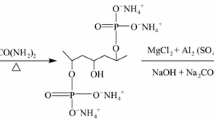Abstract
Epoxy/glass fiber hybrid composites with organo-montmorillonite (OMMT) and decabromodiphenyl oxide (DBDPO) flame retardants were prepared by vacuum-assisted resin infusion technique. The effects of OMMT and DBDPO on the flammability properties of epoxy/glass fiber hybrid composites were evaluated through UL-94 vertical flammability test and limiting oxygen index (LOI). Thermal decomposition was studied by means of thermogravimetric analyzer (TG). Field emission scanning electron microscopy (FESEM) was used to study the char morphology of the epoxy hybrid composites after being subjected to UL-94 vertical flammability test. Epoxy/glass fiber/OMMT hybrid composites with DBDPO loading of 40 wt% showed V-1 rating, whereas an increase to 50 wt% loading showed V-0 rating. The LOI values increased from 22.7 to 39.9 % as the loading of DBDPO increased. The obtained TG results showed that the thermal stability of epoxy hybrid composites decreased as the DBDPO loading increased. DBDPO decomposed at a lower temperature to form bromine radicals, which reacted with the combustible gases to form hydrogen bromide to inhibit the flame spread in the gas phase. The condensed phase activity was shown in FESEM, in which a layer of compact and continuous char was formed in epoxy/glass fiber/OMMT/DBDPO hybrid composites.




Similar content being viewed by others
References
Luda MP, Balabanovich AI, Zanetti M, Guaratto D. Thermal decomposition of fire retardant brominated epoxy resins cured with different nitrogen containing hardeners. Polym Degrad Stab. 2007;92(6):1088–100.
Ahamad T, Alshehri S. Thermal degradation and evolved gas analysis of epoxy (DGEBA)/novolac resin blends (ENB) during pyrolysis and combustion. J Thermal Anal Calorim. 2012:1–7. doi:10.1007/s10973-012-2431-2.
Wu K, Shen M–M, Hu Y, Xing W, Wang X. Thermal degradation and intumescent flame retardation of cellulose whisker/epoxy resin composite. J Therm Anal Calorim. 2011;104(3):1083–90.
Dodds N, Gibson AG, Dewhurst D, Davies JM. Fire behaviour of composite laminates. Compos Part A: Appl Sci Manuf. 2000;31(7):689–702.
Levchik SV, Weil ED. Thermal decomposition, combustion and flame-retardancy of epoxy resins—a review of the recent literature. Polym Int. 2004;53(12):1901–29.
Green J. 25 years of flame retarding plastics. J Fire Sci. 1997;15(1):52–67.
Weil ED, Levchik S. A review of current flame retardant systems for epoxy resins. J Fire Sci. 2004;22(1):25–40.
Weil ED, Levchik SV. Flame retardants in commercial use or development for polyolefins. J Fire Sci. 2008;26(1):5–43.
Clarke FB. The effects of brominated flame retardants on the elements of fire hazard: a re-examination of earlier results. Fire Mater. 1999;23(3):109–16.
Hardy ML. Regulatory status and environmental properties of brominated flame retardants undergoing risk assessment in the EU: DBDPO, OBDPO, PeBDPO and HBCD. Polym Degrad Stab. 1999;64(3):545–56.
Dauengauer SA, Utkina OG, Sazanov YN. Thermal and thermo-oxidative degradation of polystyrene in the presence of bromine-containing flame retardants. J Therm Anal Calorim. 1988;33(4):1213–9.
Toure B, Cuesta JML, Gaudon P, Benhassaine A, Crespy A. Fire resistance and mechanical properties of a huntite/hydromagnesite/antimony trioxide/decabromodiphenyl oxide filled PP-PE copolymer. Polym Degrad Stab. 1996;53(3):371–9.
Gilman JW, Jackson CL, Morgan AB, Harris R, Manias E, Giannelis EP, Wuthenow M, Hilton D, Phillips SH. Flammability properties of polymer-layered-silicate nanocomposites. Polypropylene and polystyrene nanocomposites. Chem Mater. 2000;12(7):1866–73.
Grause G, Ishibashi J, Kameda T, Bhaskar T, Yoshioka T. Kinetic studies of the decomposition of flame retardant containing high-impact polystyrene. Polym Degrad Stab. 2010;95(6):1129–37.
Wu Q, Zhang C, Liang R, Wang B. Combustion and thermal properties of epoxy/phenyltrisilanol polyhedral oligomeric silsesquioxane nanocomposites. J Therm Anal Calorim. 2010;100(3):1009–15.
Morgan AB, Harris RH, Kashiwagi T, Chyall LJ, Gilman JW. Flammability of polystyrene layered silicate (clay) nanocomposites: carbonaceous char formation. Fire Mater. 2002;26(6):247–53.
Toldy A, Anna P, Csontos I, Szabó A, Marosi G. Intrinsically flame retardant epoxy resin: fire performance and background—part I. Polym Degrad Stab. 2007;92(12):2223–30.
Bartholmai M, Schartel B. Layered silicate polymer nanocomposites: new approach or illusion for fire retardancy? Investigations of the potentials and the tasks using a model system. Polym Adv Technol. 2004;15(7):355–64.
Song R, Wang Z, Meng X, Zhang B, Tang T. Influences of catalysis and dispersion of organically modified montmorillonite on flame retardancy of polypropylene nanocomposites. J Appl Polym Sci. 2007;106(5):3488–94.
Samyn F, Bourbigot S, Jama C, Bellayer S. Fire retardancy of polymer clay nanocomposites: is there an influence of the nanomorphology? Polym Degrad Stab. 2008;93(11):2019–24.
Lee YH, Kuboki T, Park CB, Sain M, Kontopoulou M. The effects of clay dispersion on the mechanical, physical, and flame-retarding properties of wood fiber/polyethylene/clay nanocomposites. J Appl Polym Sci. 2010;118(1):452–61.
Camino G, Tartaglione G, Frache A, Manferti C, Costa G. Thermal and combustion behaviour of layered silicate–epoxy nanocomposites. Polym Degrad Stab. 2005;90(2):354–62.
Park Y, Ayoko G, Kristof J, Horváth E, Frost R. Thermal stability of organoclays with mono- and di-alkyl cationic surfactants. J Thermal Anal Calorim. 2011:1–7. doi:10.1007/s10973-011-2025-4.
Schartel B, Bartholmai M, Knoll U. Some comments on the main fire retardancy mechanisms in polymer nanocomposites. Polym Adv Technol. 2006;17(9–10):772–7.
Hu Y, Wang S, Ling Z, Zhuang Y, Chen Z, Fan W. Preparation and combustion properties of flame retardant nylon 6/montmorillonite nanocomposite. Macromol Mater Eng. 2003;288(3):272–6.
Si M, Zaitsev V, Goldman M, Frenkel A, Peiffer DG, Weil E, et al. Self-extinguishing polymer/organoclay nanocomposites. Polym Degrad Stab. 2007;92(1):86–93.
Okoshi M, Nishizawa H. Flame retardancy of nanocomposites. Fire Mater. 2004;28(6):423–9.
Morgan AB, Chu LL, Harris JD. A flammability performance comparison between synthetic and natural clays in polystyrene nanocomposites. Fire Mater. 2005;29(4):213–29.
Isitman NA, Gunduz HO, Kaynak C. Nanoclay synergy in flame retarded/glass fibre reinforced polyamide 6. Polym Degrad Stab. 2009;94(12):2241–50.
Morgan AB. Flame retarded polymer layered silicate nanocomposites: a review of commercial and open literature systems. Polym Adv Technol. 2006;17(4):206–17.
Lu SY, Hamerton I. Recent developments in the chemistry of halogen-free flame retardant polymers. Prog Polym Sci. 2002;27(8):1661–712.
Kandola BK, Horrocks AR. Composites. In: Horrocks AR, Price D, editors. Fire retardant materials. Cambridge: Woodhead; 2001. p. 182–203.
Schartel B, Knoll U, Hartwig A, Pütz D. Phosphonium-modified layered silicate epoxy resins nanocomposites and their combinations with ATH and organo-phosphorus fire retardants. Polym Adv Technol. 2006;17(4):281–93.
Hartwig A, Pütz D, Schartel B, Bartholmai M, Wendschuh-Josties M. Combustion behaviour of epoxide based nanocomposites with ammonium and phosphonium bentonites. Macromol Chem Phys. 2003;204(18):2247–57.
Kaynak C, Nakas GI, Isitman NA. Mechanical properties, flammability and char morphology of epoxy resin/montmorillonite nanocomposites. Appl Clay Sci. 2009;46(3):319–24.
Leszczynska A, Pielichowski K. Application of thermal analysis methods for characterization of polymer/montmorillonite nanocomposites. J Therm Anal Calorim. 2008;93(3):677–87.
Chiang CL, Hsu SW. Synthesis, characterization and thermal properties of novel epoxy/expandable graphite composites. Polym Int. 2010;59(1):119–26.
Leszczyńska A, Njuguna J, Pielichowski K, Banerjee JR. Polymer/montmorillonite nanocomposites with improved thermal properties: part I. Factors influencing thermal stability and mechanisms of thermal stability improvement. Thermochim Acta. 2007;453(2):75–96.
Pereira S, Rocha L, Novák C, Nascimento RSV. Clays basal spacings effect on fire retardancy of polymers by TG/DTA. J Therm Anal Calorim. 2011;106(2):535–9.
Velmurugan R, Mohan TP. Epoxy-clay nanocomposites and hybrids: synthesis and characterization. J Reinf Plast Compos. 2009;28(1):17–37.
Antoš K, Sedlář J. Influence of brominated flame retardant thermal decomposition products on HALS. Polym Degrad Stab. 2005;90(1):188–94.
Price D, Anthony G, Carty P. Introduction: polymer combustion, condensed phase pyrolysis and smoke formation. In: Horrocks AR, Price D, editors. Fire retardant materials. Cambridge: Woodhead; 2001. p. 1–30.
Lu H, Wilkie CA. Synergistic effect of carbon nanotubes and decabromodiphenyl oxide/Sb2O3 in improving the flame retardancy of polystyrene. Polym Degrad Stab. 2010;95(4):564–71.
Peng SH, Chen LQ, Li LB, Xie MQ. Thermal decomposition of decabromodiphenyl ether during the temperature rising of flame-retarded HIPS resin in fire. Proc Eng. 2011;11:349–54.
Lewin M, Weil ED. Mechanisms and modes of action in flame retardancy of polymers. In: Horrocks AR, Price D, editors. Fire retardant materials. Cambridge: Woodhead; 2001. p. 31–68.
Price D. Brominated flame retardants: mechanism of action. In: Proceedings on workshop on brominated flame retardants. Sweden: Skoklester; 1998.
Howell B. Thermal properties of compounds possessing both solid-phase and gas-phase flame retardant potential. J Therm Anal Calorim. 2007;89(2):373–7.
Yu L, Wang W, Xiao W. The effect of decabromodiphenyl oxide and antimony trioxide on the flame retardation of ethylene-propylene-diene copolymer/polypropylene blends. Polym Degrad Stab. 2004;86(1):69–73.
Chen XS, Yu ZZ, Liu W, Zhang S. Synergistic effect of decabromodiphenyl ethane and montmorillonite on flame retardancy of polypropylene. Polym Degrad Stab. 2009;94(9):1520–5.
Singha AS, Thakur VK. Synthesis and characterization of short Grewia optiva fiber-based polymer composites. Polym Compos. 2010;31(3):459–70.
Weil ED, Hansen RH, Patel N. Prospective approaches to more efficient flame-retardant systems. In: Nelson GL, editor. Fire and polymers: hazards identification and prevention. ACS symposium series, vol 425. Washington, DC: American Chemical Society; 1990. p. 97–8.
Acknowledgements
This study was funded by the Universiti Sains Malaysia Short Term Grant (Grant number: 60310024), the USM Incentive Grant (Grant number: 8021013), Postgraduate Research Grant Scheme (Grant number: 8034004) and USM Fellowship.
Author information
Authors and Affiliations
Corresponding author
Rights and permissions
About this article
Cite this article
Chang, L.N., Jaafar, M. & Chow, W.S. Thermal behavior and flammability of epoxy/glass fiber composites containing clay and decabromodiphenyl oxide. J Therm Anal Calorim 112, 1157–1164 (2013). https://doi.org/10.1007/s10973-012-2681-z
Received:
Accepted:
Published:
Issue Date:
DOI: https://doi.org/10.1007/s10973-012-2681-z




